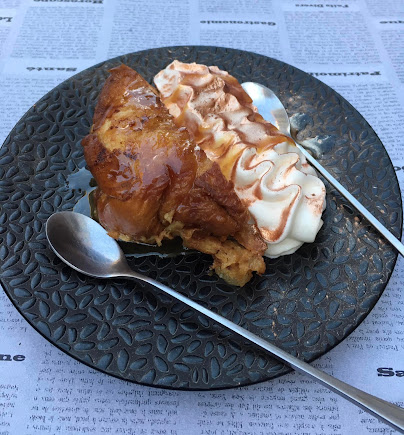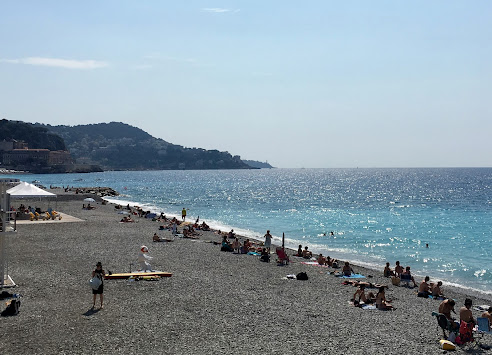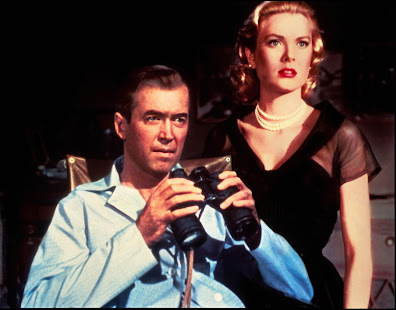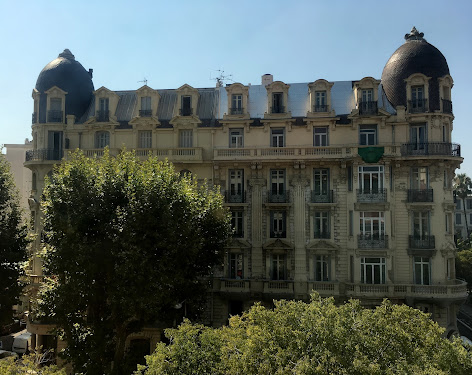Our tour schedule for this morning:
For now it's time to bid a fond au revoir to the Best of France and your fellow travelers at the end of a magical and memorable holiday.
Trafalgar provided a shuttle to the airport, and we left the hotel mid-morning with eight or ten others who were flying home. Martha asked some of them what the most memorable part of the tour had been for them. Some said Omaha Beach, some said Nice. We were sorry that we had missed the former but glad that we had had plenty of time to explore Nice.
Travel is always interesting, and sometimes difficult. The flight from Charlotte to London over two weeks ago had been uneventful. We had sipped a glass of wine, eaten some of the surprisingly edible airplane food, and watched a movie. But the lingering effects of Covid meant, without going into any detail, that I had taken some Imodium this morning, which I learned should not be taken with Dramamine. That in return made the nine-hour flight to Philadelphia very unpleasant. I never knew that I was so prone to motion sickness on an airplane, and realized I had never flown before now without the benefits of Dramamine. I had no desire for wine, or food, or a movie, and there was a small child directly behind me who spent the latter half of the flight crying miserably, which echoed my own feelings although I remained stoically silent, hunched over between an understanding woman on the aisle and my sympathetic wife at the window, who somehow produced a welcome pair of earplugs.
There were long lines at Philadelphia International Airport, and it was raining outside when we landed, the first rain we had seen in three weeks. Because we were returning from overseas, we had to pass through a few more steps – maybe “run the gauntlet” describes it more accurately – before being admitted to the land of the free and the home of the brave. We could have spent a very long time at the incomprehensible kiosk which appeared at the end of a switch-backing line but for a helpful employee, in an airport that was woefully understaffed, who walked us through it. The touch screen asked us if we had all manner of things to declare, including chickens. “I left my chickens in the parking lot in Paris,” I told her. She looked like she had a sense of humor and she did; otherwise, a joke like that might have led to my being strip-searched by the TSA.
Martha seemed to have little trouble passing the next hurdle, but I was inexplicably required to remove my shoes and was carefully searched as I passed through the screening portal.
“What’s this in your pocket?” I was asked gruffly. We had already emptied our pockets, placed our liquids in a clear baggie, and deposited wallet, phone, and carry-on on the conveyor belt. It was the earplugs, I discovered, dropped into my shirt pocket and forgotten. “Crying child behind me on a nine-hour flight,” I explained, and he seemed to sympathize with me.
Although we had left Paris mid-afternoon, we had passed through six time zones, so we arrived around 5:00 p.m. As we retrieved our baggage and checked it again for the transfer to Charlotte, we realized that we were in an increasingly narrowing window between the two flights, especially when we found ourselves in another line for a very long time. Many travelers in line with us had already missed their flights. One man was very philosophical about it. He told a very agitated man in line behind us, “Oh, we missed ours too; it’s already in the air!” He was almost cheerfully. What would we do if we missed the flight to Charlotte? we wondered. Our baggage would be there, unloaded onto a conveyor belt, and we would be here in Philadelphia 500 miles away, presumably trying to find a hotel for the night.
As luck would have it, our flight was delayed a couple of hours, and we eventually found ourselves in a comfortable lounge area at the loading gate, waiting once again. But the flight to Charlotte was only an hour or two long, and it was a good one. The airplane had plenty of leg room and was not crowded, and when they dimmed the lights we both took little catnaps. What a relief to finally see the lights of Charlotte below us!
Our suitcases were miraculously among the first to appear on the conveyor belt, and Martha called the number for the shuttle to our hotel. By this time we were beyond exhaustion, operating entirely on nervous energy. The Holiday Inn shuttle finally appeared, and we climbed in gratefully. It was driven by an African American woman who was friendly and had a good sense of humor. She asked us where we had been and she said, “It’s always good to get home, isn’t it? You want to get gone so bad, and then you want to get home!” I told her I was not looking forward to mowing our knee-high lawn, but maybe I could use jet lag as an excuse. She laughed merrily at that, “Oh yeah, honey, jet lag! You can milk that for a long time!” It was nice to be greeted by such a down-to-earth woman after being in the air for so long.
Our hotel at last! We
slept like babies. And not the kind who
cry.
The next day we had a nice breakfast at the hotel and started on our three-hour drive to Highlands. And our Honda CRV started without hesitation! It was warm and humid, and it rained off and on. We were back home, late July in North Carolina, thundershowers every afternoon. It was indeed good to get home.
A few days later, I wrote this on our little blackboard in the kitchen:

















































